Corner sink: design features and existing varieties
Corner sink of stainless steel or artificial stone will allow much more efficient use of kitchen space. This option is especially relevant for small premises. In this article we will look at this type of sink in more detail.
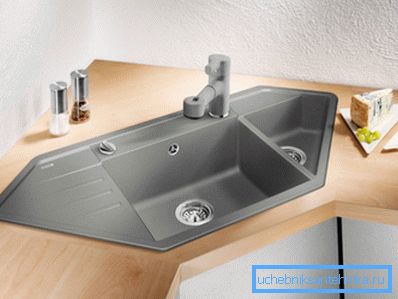
Character traits
To begin, let us analyze the pros and cons of the corner wash:
Merits
- The most important advantage is to save space, which we have already mentioned. The sink is installed in a corner, which otherwise usually remains unclaimed, and does not occupy a useful area along the walls of the kitchen.

- Convenience of operation. At the time of using the corner sink to do something on the table, you do not need to take even one step, just turn around a little.
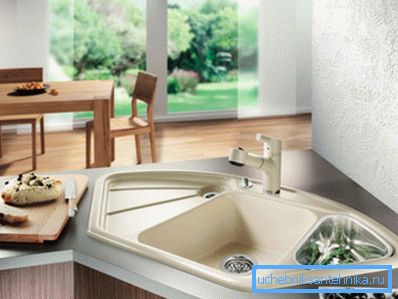
- Additional compartments for storing kitchen utensils. Corner bollard with sink can contain cleaning products, powder, plunger and other necessary things in everyday life.
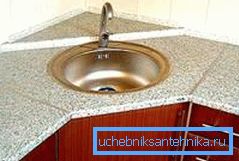
Tip: it is recommended to choose a cabinet for the sink complete with the rest of the kitchen furniture, so that it does not stand out from the general interior.
- Variety of models. On the shelves of specialized stores you can find a variety of variations of the considered structures and additional accessories to them.
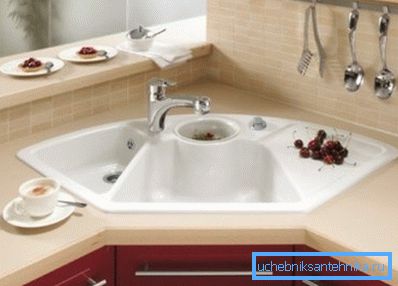
- Another exploited zone in the corner directly behind the sink itself.. Sometimes even a convenient special shelf is constructed on this place.

- The ability to perform the installation yourself. Corner sink do-it-yourself mounted as well as the standard.
Disadvantage
The only negative feature of such models is that if you want to perform a rearrangement of the special options for the placement of the corner sink in the kitchen, only the corners farthest from the door. But this is a relative minus.
Kinds
Corner sinks are made of a variety of materials:
Possible materials of manufacture

| Material | pros | Minuses |
| Stainless steel |
|
|
| Fake diamond |
|
|
| Ceramics |
|
|
| Enameled steel |
|
|
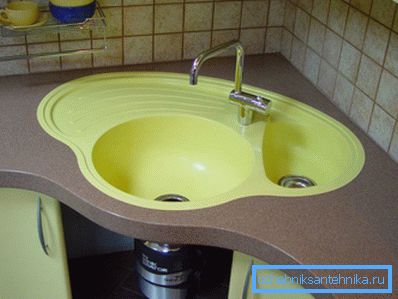
Design features

According to the presence or absence of additional elements, the corner shells are divided into the following variations:
| Type of | Special features |
| With one cup | Standard low-cost model with no add-ons. |
| With two or three bowls | It is possible to simultaneously wash food and dishes in different containers |
| With wing | A special ribbed plane, which protects the tabletop from moisture and serves to place wet products or dishes on it, goes to the side. |
Tip: it is recommended to equip the construction with two or three bowls with a mixer with a pull-out spout. This will make it possible to equally effectively get a stream of water even in the most remote corners of the sink.
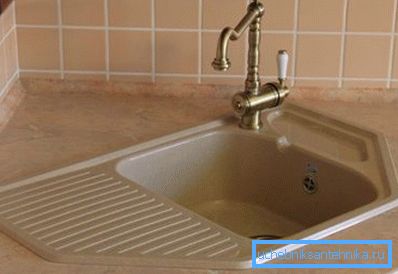
Types of installation
Today, the most common are the three installation options for washing:
- Overhead. In this case, the bowl is placed on the tabletop, resting on it with its sides, or at the ends of the walls of the stand. Such a method is distinguished by a simple execution instruction.
- Mortise. Here, the sink crashes right into the countertop, sinking into it. This is somewhat more difficult to do, but the result is more aesthetic and easy to use.
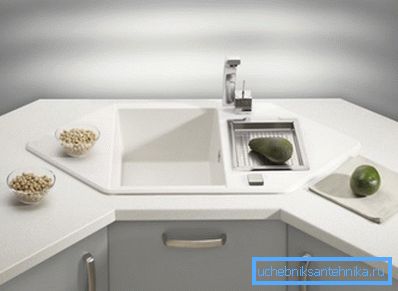
- Integrated. This method is similar in technology to the previous one, only more complicated in design, since with it the edges of the bowl go below the level of the tabletop. Performed exclusively by experts.
Dimensions
The dimensions of the corner sink can be very different, but the choice should be made strictly in accordance with the linear parameters of the cabinet on which the installation will be performed. In the opposite case, you have in the end the edge of the shell may simply not fit in the allotted place.
As for the depth, it should be at least 200 mm in order to minimize the amount of sprays flying out of the edges of the bowl.
Optional accessories
With corner sinks can be used:
- Laid on cutting boards. They are sized to fit exactly over the bowl, which makes it possible to more efficiently use the useful kitchen space.

- Baskets for drying. Inserted into the sink, after which you can put wet foods or dishes in them, which will allow water from them to flow directly into the drain hole.
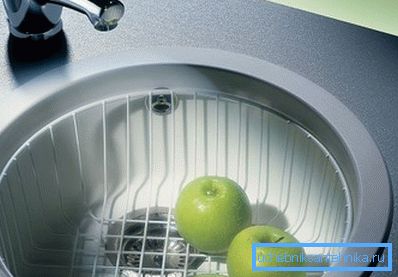
Conclusion
Corner sinks have an attractive appearance and, more importantly, allow more economical use of the area of the room. They have a wide range, thanks to which you will surely choose the model that suits your requirements. The above recommendations will help you in making choices.
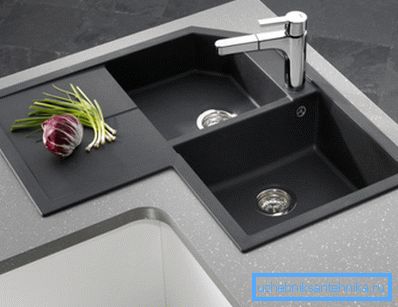
The video in this article will acquaint you with additional information. The corner sink made of artificial stone or stainless steel will allow you to more rationally equip a small-sized kitchen.